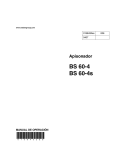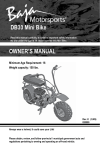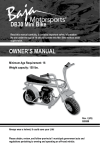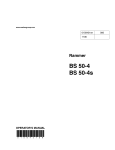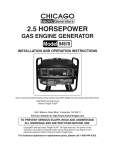Download PRO-SERIES CMG5 Instructions / Assembly
Transcript
201107 CMG5 5 Cu Ft CEMENT MIXER INSTRUCTION MANUAL READ ALL INSTRUCTIONS AND WARNINGS BEFORE USING THIS PRODUCT. This manual provides important information on proper operation & maintenance. Every effort has been made to ensure the accuracy of this manual. These instructions are not meant to cover every possible condition and situation that may occur. We reserve the right to change this product at any time without prior notice. IF THERE IS ANY QUESTION ABOUT A CONDITION BEING SAFE OR UNSAFE, DO NOT OPERATE THIS PRODUCT! DO NOT RETURN THIS PRODUCT TO THE RETAILER - CONTACT CUSTOMER SERVICE. If you experience a problem, have questions or need parts for this product, call Customer Service at 1-888-287-6981, Monday-Friday, 8 AM - 4 PM Central Time. A copy of the sales receipt is required. FOR CONSUMER USE ONLY – NOT FOR PROFESSIONAL USE. KEEP THIS MANUAL, SALES RECEIPT & APPLICABLE WARRANTY FOR FUTURE REFERENCE. CMG5 Cement Mixer FEATURES: • • • • • • • • • Belt Size 23 5/8” length Fuel Type: Gasoline Fuel Capacity 0.3698 gallons (1.4L ) Oil Type SAE10W-30 Oil Capacity 15.2 ounces (0.45 liters) Decibel rating: 101 dB 5 Cu Ft batch output 2.5 HP Drum Speed 24 RPM @ 2,800 RPM IMPORTANT SAFETY INSTRUCTIONS STOP! Before using this cement mixer, if you have any questions regarding the hazard and safety notices listed in this manual and/or on this cement mixer, call 1-888-287-6981, Monday - Friday, 8 AM - 4 PM Central Time. Carbon Monoxide Gas: When in operation, the exhaust from this cement mixer contains poisonous carbon monoxide gas. Carbon monoxide gas is both odorless and colorless AND may be present even if you do not see or smell gas. Breathing this poison gas can lead to headaches, dizziness, drowsiness, loss of consciousness and eventually death. • USE THIS CEMENT MIXER ONLY OUTDOORS IN NON-CONFINED AREAS. DO NOT SECURE THE CEMENT MIXER WITH A CHAIN OR ROPE, AS THIS WILL MAKE IT DIFFICULT TO MOVE IN AN EMERGENCY. • Keep at least several feet of clearance on all sides to allow proper ventilation. Chemicals: According to the State of California, the dust and exhaust from this CEMENT MIXER contains chemicals known to cause cancer, birth defects, or other reproductive harm. Flammable Gasoline: This cement mixer may emit highly flammable and explosive gasoline vapors, which can cause severe burns or even death. A nearby open flame can lead to an explosion even if not directly in contact with gasoline. • Do not operate near open flame. • Always operate on a firm, level surface. Gasoline is highly flammable and explosive. Handling fuel can result in serious injury or burns. • Always shut down before refueling. Refuel in a well-ventilated area. Keep heat, sparks and flame away while refueling and away from the location where gasoline is stored. Never refuel indoors where gasoline fumes may reach flames and/or sparks. • Allow to cool for at least 2 minutes before removing the fuel tank cap. Loosen the cap slowly to relieve pressure in the fuel tank. Avoid spilling fuel. • Do not fill the fuel tank above the upper limit line. Gasoline may expand during operation. Do not fill to the top of the tank. • Always check for spilled gasoline and immediately wipe it up before starting. • Empty the fuel tank before storing or transporting. • Always handle fuel outdoors. • Before transporting, turn the fuel valve to the “OFF” position and disconnect the spark plug. Do not smoke during use. Nicotine reduces the blood supply to the hands and fingers, increasing the risk of vibration-related injury. Wear suitable gloves to reduce the vibration effects on the user. CMG5 2.5 Cu Ft. Cement Mixer 2 High Temperatures: This cement mixer produces heat when in operation. Temperatures near the exhaust can exceed 150 Degrees Fahrenheit (65 Degrees Celsius). • Do not touch hot surfaces. Observe all warning placards denoting hot surfaces. • Allow to cool for several minutes after use before touching the engine, muffler or other areas that are hot during operation and before storing indoors. • Hot exhaust may ignite some materials. Keep flammable materials away. • Keep at least several feet of clearance on all sides during operation. Do not enclose in any structure. Usage: Misuse can damage it or shorten its life. • Use for its intended purpose. • Operate only on a dry, level surface. Do not secure with a chain or rope, which would prevent it from being moved in an emergency. • Promptly turn off any malfunctioning devices and disconnect them. CMG5 2.5 Cu Ft. Cement Mixer 3 In addition to the previously described safety information, familiarize yourself with all safety and hazard placards on this Cement Mixer. 2 1 5 4 9 6 3 12 7 8 COMPONENTS Observe the locations and functions of the various components and controls. 1) 2) 3) 4) 5) 6) Handle Grip Engine Cover Drum Opening Gas Tank Drum Warning Label 7) Support Leg 8) Wheels 9) Engine 10) Recoil Start 11) Air Filter 12) Gas Tank 11 10 This tool vibrates during use. Repeated or long-term exposure to vibration may cause temporary or permanent physical injury, particularly to the hands, arms and shoulders. Anyone using vibrating tools regularly or for an extended period should first be examined by a doctor and then have regular medical check-ups to ensure medical problems are not being caused or worsened from use. Pregnant women or people who have impaired blood circulation to the hand, past hand injuries, nervous system disorders, diabetes, or Raynaud’s Disease should not use this tool. If you feel any medical or physical symptoms related to vibration (such as tingling, numbness, and white or blue fingers), seek medical advice as soon as possible. CMG5 2.5 Cu Ft. Cement Mixer 4 STOP! The following section describes the required steps for preparing this tool for the first use. Failure to correctly perform these steps can damage this tool and/or shorten its life. If still unsure about how to perform any of these steps after reading this section, call 1-888-287-6981 Monday - Friday, 8 AM - 4 PM Central Time for customer service. If this cement mixer is being used for the first time, the following few steps are required to prepare it for operation: Step 1 - Add Oil This cement mixer requires engine oil to function. Engine oil is a major factor affecting engine performance and service life. When new from the package, this cement mixer contains no oil in the engine crankcase. Add the correct quantity of oil before operating for the first time. When replenishing oil for subsequent use, always determine that this cement mixer has the correct quantity of oil. Oil Capacity (fluid oz./L) Oil Type Recommended 15.2 ounces (0.45 liters ) SAE10W-30 To add oil: 1. Confirm that this cement mixer is on a level surface. 2. Open the Oil Access Panel as illustrated in Figure 1. 3. Using a funnel, add high detergent motor oil to fill the engine crankcase to the correct quantity as stated above. SAE10W-30 oil is recommended. When the engine crankcase is full, the oil level should reach the lower lip of the oil filling opening as illustrated in Figure 2. 4. Replace the oil filler/dipstick cap and close the oil access panel. Step 2 - Add Gasoline Gasoline and gasoline fumes are highly flammable and explosive. Handling fuel can result in serious injury or burns. • Do not fill the fuel tank near a heat, sparks or an open flame. Keep gasoline away from appliance pilot lights, barbecues, electric appliances, power tools, etc. • Do not overfill the fuel tank. Check for fuel spills and immediately wipe them up. Spilled fuel is a fire hazard and causes environmental damage. To add gasoline: To ensure that this cement mixer runs smoothly, use only FRESH, UNLEADED GASOLINE WITH AN OCTANE RATING OF 87 OR HIGHER. Unleaded gasoline produces fewer engine and spark plug deposits and extends the life of the exhaust system. 1. Confirm that this cement mixer is on a level surface. 2. Unscrew fuel tank cap and set aside. (NOTE: The fuel tank cap may be tight and difficult to unscrew.) 3. Slowly add fresh, unleaded gasoline (with an octane rating 87 or higher) to the fuel tank. Be careful not to fill the fuel tank above the upper limit line. NOTE: Because gasoline can expand, do not fill the fuel tank to the very top. 4. Securely tighten the fuel tank cap and immediately wipe up any spilled gasoline with a dry cloth. Fuel Tank Capacity (gals /L) Fuel Type 0.3698 gallons (1.4 Liters ) Fresh, Unleaded Gasoline Octane Rating 87 or Higher IMPORTANT: • Use only UNLEADED gasoline with an octane rating of 87 or higher. • Never use a mixture of oil and gasoline. • Never use old and/or contaminated gasoline. • Avoid getting dirt and/or water in the fuel tank. • Gasoline can age in the fuel tank and make it difficult to start. Never store this for extended time with gasoline in the fuel tank. CMG5 2.5 Cu Ft. Cement Mixer 5 Subsequent Use of this Cement Mixer For subsequent uses of this tool after the first use, certain steps still must be completed to prepare it for operation. IMPORTANT: Be familiar with the procedures described in the previous section titled “Using the Cement Mixer for the First Time” of this manual. If not, review this section now. Step 1 - Verify Oil Level Step 2 - Verify Gas Level Before starting, verify that there is sufficient gasoline in the fuel tank. If necessary, add fresh unleaded gasoline with an octane rating of 87 or higher. People with pacemakers should consult their physician before use. Electromagnetic fields in close proximity to heart pacemaker could cause pacemaker interference or pacemaker failure. IMPORTANT: • Use only fresh UNLEADED gasoline with an octane rating of 87 or higher. • Never use old and/or contaminated gasoline. • Never use a mixture of oil and gasoline. • Avoid getting dirt and/or water in the fuel tank. • Never store for extended time with gasoline in the fuel tank. Gasoline and gasoline fumes are highly flammable and explosive. Handling fuel can result in serious injury or burns. • Do not fill the fuel tank near a heat, sparks or an open flame. Keep gasoline away from appliance pilot lights, barbecues, electric appliances, etc. • Always allow several minutes for the engine to cool before refueling. • Do not overfill the fuel tank. Check for fuel spills and immediately wipe them up. Spilled fuel is a fire hazard and causes environmental damage. STARTING THE CEMENT MIXER STOP! Before starting, confirm that all the steps in the section titled, “Preparing the Cement Mixer for Use,” of this manual have been completed. Place the Concrete Mixer on a solid, even surface. To start this cement mixer: 1. Turn the fuel valve to the “on” position. 2. Move the choke lever to the “closed” position. 3. Set the engine switch to the “on” position. 4. Slowly pull on the recoil starter handle, shown in Figure 4, until a slight resistance is felt. Then pull briskly to start the engine. Gently return the cord to avoid damage to the starter or housing. Never allow the cord to snap back. 5. If the engine fails to start, repeat step 6. NOTE: After repeated attempts to start the engine, consult the troubleshooting guide before attempting again. If problems persist, call 1-888-287-6981, Monday - Friday, 8 AM - 4 PM Central Time. 6. Once the engine has started and runs for about a minute, move the choke lever approximately half way towards the “open” position. Wait an additional 30 seconds and then move the choke lever completely over to the “open” position. Figure 4 CMG5 2.5 Cu Ft. Cement Mixer 6 USING THE CEMENT MIXER • USE ONLY OUTDOORS IN NON-CONFINED AREAS. DO NOT SECURE WITH A CHAIN OR ROPE, AS THIS WILL MAKE IT DIFFICULT TO MOVE IN AN EMERGENCY. • Keep at least several feet of clearance on all sides to allow proper ventilation. Add material to the Drum. Typical maximum quantities include: 2 gallons water with 3 shovels of cement and 15 shovels aggregate rock. Disengage the locking pins on the Arm and push on Arm until the desired angle is reached. Re-engage the locking pins. Once materials are mixed, tilt Drum and dump materials where needed. The materials are dumped while the Drum is rotating. Tilt the Drum angle as far down as possible to drain all fluids from Drum. Clean, then store indoors and out of children’s reach. BELT TENSION Retighten belt after the first 25 hours of use. To test the tension, remove belt cover. Examine belt for cracks, tears in the backing, or other damage. Replace belt if damaged according to these steps: Loosen the motor bracket bolts and slide the bracket up as far as possible. Slide the old belt off of the larger pulley first, then remove it from the motor pulley. Put the new belt around the small pulley first, then around the large pulley. Move the motor bracket down the belt until it is properly tensioned according to the directions below. Tighten the motor bracket bolts. Check and adjust belt tension according to these steps: Press on the center of the longest span on the belt with moderate finger pressure. Then measure the deflection distance, the distance that the belt moved. The belt should deflect anywhere from 1/2” to 3/4”. If the belt deflects too much, tighten belt by loosening the motor mounting bolts and moving the motor away from the other pulley slightly. Secure motor mounting bolts and retest tension. If the belt is too long to be properly tensioned, it must be replaced. If the belt deflects too little, loosen the motor bracket bolts and lift it upward. Secure motor mounting bracket and retest tension. Before use, replace belt motor cover. CMG5 2.5 Cu Ft. Cement Mixer 7 STOPPING THE CEMENT MIXER To stop this cement mixer: 1. Switch the circuit breaker to the “OFF” position. 2. Allow to run for several more minutes to help stabilize the temperature. 3. Set the engine switch to the “OFF” position. 4. Turn the fuel valve to the “OFF” position. Allow this to cool down before touching areas that become hot during operation. Allowing gasoline to sit in the fuel tank for extended time without use can increase the difficulty in starting in the future. Never store for extended time with gasoline in the fuel tank. MAINTENANCE/CARE Proper routine maintenance of this tool is essential for safe, economical, and trouble-free operation. It will help prolong the life as well as help reduce air pollution. Perform maintenance checks and procedures according to the schedule in Figure 7. Never perform maintenance procedures while this cement mixer is running. Allow to cool before commencing any maintenance procedures. Keep heat, sparks and flame away. Improper maintenance and/or failure to correct any problems prior to operating this cement mixer can cause a malfunction which could cause death or serious injury. Always follow the inspection and maintenance recommendations and schedules in this manual. Each Use Engine Oil Air Filter Fuel Filler Cap Spark Plug Fuel Tank Check Level Replace Check Clean Clean Check/Clean Verify Gas Level Clean X Every Month or Each 20 Hrs X Every 3 Months or Each 50 Hrs Every 6 Months or Each 100 Hrs Every Year or Each 300 Hrs X X X X X Figure 7 - Recommended maintenance schedule X Checking the Oil Level It is important to check the oil level in the engine crankcase before each use to ensure that there is a sufficient quantity. To check the oil level: 1. Verify that this engine is shut down and on a level surface. 2. Unscrew the oil filler/dipstick cap from the engine. 3. With a dry cloth, wipe the oil off of the dipstick that is located on the inside of the cap. 4. Insert the dipstick as if replacing the cap and then remove again. There should be oil on the dipstick. If there is no oil on the dipstick, or oil is visible only at the very end of the dipstick, add oil until the engine crankcase is filled. 5. Confirm that the oil filler/dipstick cap is properly in place when finished verifying the oil level. CMG5 2.5 Cu Ft. Cement Mixer 8 Changing/Adding Oil The oil level should be checked before each use. (See Figure 8.) When the oil level is low, add oil until the level is sufficient to operate. Oil Capacity (fluid oz./L) Oil Type Recommended 15.2 ounces (0.45 liters ) SAE10W-30 To drain the oil: It is necessary to drain the oil from the crankcase only if it has become contaminated with water and/or dirt. 1. Place a bucket underneath to catch oil as it drains. 2. Unscrew the oil drain plug located on the crankcase underneath the oil filler/dipstick cap. 3. Allow all the oil to drain. 4. Replace the oil drain plug and tighten. NOTE: Never dispose of used motor oil in the trash, down a drain or on the ground. Put oil in a sealed container and contact your local recycling center or auto garage to arrange oil disposal. To add oil to the engine crankcase: 1. Confirm that the cement mixer is on a level surface. 2. Unscrew the oil filler/dipstick cap from the engine as illustrated in Figure 8 below. 3. Using a funnel, add high detergent motor oil to fill the engine crankcase to the correct quantity. SAE10W-30 oil is recommended for general use. When the engine crankcase is full, the oil level should reach the lower lip of the oil filling opening as shown in Figure 8. Oil Capacity (fluid oz./L) Oil Type Recommended 20 / 0.59 High Detergent Motor Oil, SAE10W-30 Air Filter Maintenance Figure 8 Routine maintenance of the air filter helps maintain proper airflow to the carburetor. Occasionally verify that the air filter is free of excessive dirt. The air filter will require more frequent cleaning when operating in extremely dusty areas. To clean air filter, remove from engine. Wash in kerosene. Pour motor oil on filter, squeeze out excess oil and reinstall in the engine. Spark Plug Maintenance The spark plug is essential for proper engine operation. The spark plug should be intact, free of deposits, and properly gapped. A bad or incorrectly installed spark plug can cause engine damage. To inspect the spark plug: 1. Remove the spark plug by pulling on the spark plug cap. (See Figure 9a.) 2. Unscrew the spark plug by using the included spark plug wrench. 3. Visually inspect the spark plug. If it is cracked and/or chipped, discard and Figure 9a Locating the spark plug install a new spark plug. E5T, BM4A, BMR4A (NGK) is recommended. Figure 9b Measuring the spark plug gap 4. Measure the spark plug electrode gap with a gauge. The gap should be (0.6-0.7mm). (See Figure 9b.) 5. If re-using the spark plug, use a wire brush to clean any dirt from around the spark plug base and then re-gap the spark plug. 6. Screw the spark plug back into place by using the included spark plug wrench. 7. Replace the spark plug cap. CMG5 2.5 Cu Ft. Cement Mixer 9 Emptying the Fuel Tank To store for extended time, drain the gasoline from the fuel tank. To drain gasoline: 1. Turn the fuel valve to the “off” position. 2. Remove the fuel filter cup. (See “Fuel Filter Cup Cleaning” earlier in this section.) 3. Empty the fuel filter cup of any fuel. 4. Place a receptacle underneath this engine to catch gasoline as it drains. 5. Turn the fuel valve to the “on” position and allow all gasoline to drain. 6. Turn the fuel valve to the “off” position. 7. Replace the fuel filter cup. 8. Store the drained gasoline in a suitable place. Do not store gasoline for more than 3 months. STORAGE/TRANSPORT PROCEDURES Never place any type of storage cover on this cement mixer while it is still hot. When transporting or storing for extended time: • Allow engine to fully cool before moving it. A hot engine and exhaust system can burn you and ignite some materials. • Empty the fuel tank. (See “Emptying the Fuel Tank” in the “Maintenance/Care” section.) • Turn the fuel valve to the “off” position. • Disconnect the spark plug. • Do not obstruct any ventilation openings. • Store in a cool dry area, free of excessive dust. Storage Time Less than 1 month 1 to 2 months 2 months to 1 year 1 year or more Recommended Storage Procedure (which will help prevent difficult starts) No storage procedure required. Fill with fresh gasoline and add gasoline conditioner Empty the fuel tank. (See “Emptying the Fuel Tank” in the “Maintenance/Care” section.) Empty the fuel tank. (See “Emptying the Fuel Tank” in the “Maintenance/Care” section.) Disconnect the spark plug. TROUBLESHOOTING IMPORTANT: If trouble persists, call our customer help line at 1-888-287-6981, Monday - Friday, 8 AM - 4 PM Central Time. Symptom Engine will not start. Cause Engine switch is set to "off." Fuel valve is turned to "closed." Choke is open. Engine is out of gasoline. Engine is filled with contaminated and/or old gasoline. Spark plug is dirty. Spark plug is broken. Cement Mixer is not on level surface. Oil is low. CMG5 2.5 Cu Ft. Cement Mixer Solution Set engine switch to "on." Turn fuel valve to "open." Close the choke. Add gasoline. Drain gasoline from the engine and add new gasoline. Clean spark plug. Replace spark plug. Move to a level surface to prevent triggering the low oil shutdown. Add or replace oil. 10 PARTS DIAGRAM CMG5 2.5 Cu Ft. Cement Mixer 11













